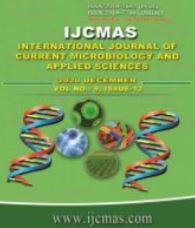


 National Academy of Agricultural Sciences (NAAS)
National Academy of Agricultural Sciences (NAAS)

|
PRINT ISSN : 2319-7692
Online ISSN : 2319-7706 Issues : 12 per year Publisher : Excellent Publishers Email : editorijcmas@gmail.com / submit@ijcmas.com Editor-in-chief: Dr.M.Prakash Index Copernicus ICV 2018: 95.39 NAAS RATING 2020: 5.38 |
The results revealed that the mean value for green wood density and drywood density varied from 802.42 Kg m-3 to 830.40 Kg m-3 and from 460.12Kg m-3 to 520.40 Kg m-3 respectively. The static bending strength ranged from 320 Kg cm-2 to 357 Kg cm-2, tension parallel to grain differed from 354 Kg cm-2 to 418 Kg cm-2 and tension perpendicular to grain ranged from 135 to 170 Kg cm-2 for different girth classes of wood. The compression strength parallel and perpendicular to grain differed from 280 to 340 Kg cm-2 and 110 to 136 Kg cm-2 respectively. The maximum veneer recovery with a value of 60% was recorded in higher girth class (90-120 cm) and minimum veneer recovery (48%) in lower girth class (30-45 cm) and the veneer shrinkage varied from 5.5% to 6.3% for different girth classes. With regard to physical properties of plywood, the plywood density ranged from 520 to 610 Kg m-3; water absorption from 16.37 to 21.50 % and thickness swelling from 4.85 to 5.86 %. The mechanical properties of plywood are the important parameters to be considered for plywood utility as a structural material. The modulus of elasticity (MOE) across the grain varied from 4371 to 5124N mm-2 and MOE along the grain ranged from 6040 to 6536 N mm-2 ,the modulus of rupture (MOR) across the grain ranged from 28.71 to 32.60 N mm-2 and MOR along the grain differed from 38 to 49 N mm-2 and glue shear strength from 1219 to1380 N mm-2 for different girth classes. The results of the present investigation have shown that Sterculia foetida wood has good physical and mechanical properties to the IS 1708 standard for plywood production. Hence, Sterculia foetida wood could be recommended for core veneer in manufacturing plywood.
 |
 |
 |
 |
 |